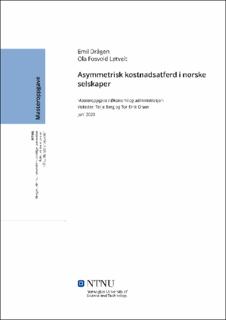| dc.contributor.advisor | Berg, Terje | |
| dc.contributor.advisor | Olsen, Tor-Eirik | |
| dc.contributor.author | Drågen, Emil | |
| dc.contributor.author | Løtveit, Ola | |
| dc.date.accessioned | 2021-09-14T17:16:57Z | |
| dc.date.available | 2021-09-14T17:16:57Z | |
| dc.date.issued | 2020 | |
| dc.identifier | no.ntnu:inspera:55685018:61216829 | |
| dc.identifier.uri | https://hdl.handle.net/11250/2777206 | |
| dc.description.abstract | I denne oppgaven studerer vi asymmetrisk kostnadsatferd, et tema som har fått økt oppmerksomhet i økonomistyringslitteraturen de siste 20 årene. Den tradisjonelle modellen for kostnadsatferd antar at kostnader endrer seg lineært i forhold til endring i aktivitet. Vi tar utgangspunkt i en alternativ modell som tar hensyn til lederes beslutninger og omstillingskostnader knyttet til endring i forpliktede ressurser, hvilket gir opphav til asymmetriske kostnader i form av stickiness og anti-stickiness. Stickiness er når kostnader øker mer for en økning i aktivitet enn de reduseres for en tilsvarende nedgang i aktivitet. Anti-stickiness er når kostnader øker mindre for en økning i aktivitet enn de reduseres for en tilsvarende nedgang i aktivitet. Vi studerer driftskostnader og driftsinntekter for norske selskaper registrert på Oslo Børs i perioden 2009-2019, med det formål å avdekke om kostnadene endrer seg lineært eller asymmetrisk i forhold til endring i aktivitet. Vi tester også kostnadsatferden i perioden før og etter oljeprisfallet i 2014, for å avdekke hvordan kostnadsatferden blir påvirket av et eksogent sjokk. For perioden 2009-2019 finner vi at driftskostnadene øker med 0,41% når aktiviteten øker med 1%, og reduseres med 0,59% når aktiviteten reduseres med 1%, altså anti-sticky kostnadsatferd. Vi finner videre anti-stickiness både i perioden før og etter oljeprisfallet, men at graden av anti-stickiness er større i perioden etter. | |
| dc.description.abstract | In this paper we study asymmetric cost behavior, a topic that has received increased attention in the management accounting literature over the last 20 years. The traditional cost behavior model assumes that costs change proportionally in response to change in activity. We use an alternative model that takes into account managers’ decisions and resource adjustment costs, giving rise to asymmetric cost behavior trough stickiness and anti-stickiness. Stickiness implies that costs increase more for an increase in activity than they decrease for an equivalent decrease in activity. On the other hand, anti-stickiness implies that costs increase less for an increase in activity than they decrease for an equivalent decrease in activity. We study operating costs and operating revenues for Norwegian companies registered on the Oslo Stock Exchange during the period 2009-2019, with the aim of detecting whether costs change proportionally or asymmetrically in response to changes in activity. We also test the cost behavior in the pre- and post-periods of the drop in oil prices in 2014 to discover how the cost behavior is affected by an exogenous shock. For the period 2009-2019, we find that operating expenses increase on average 0,41% per 1% increase in activity and decrease 0,59% per 1% decrease in activity, which implies anti-sticky cost behavior. Moreover, operating cost were anti-sticky in both the pre- and post-period of the drop in oil prices, however, the extent of cost anti-stickiness is larger in the period after. | |
| dc.language | | |
| dc.publisher | NTNU | |
| dc.title | Asymmetrisk kostnadsatferd i norske selskaper | |
| dc.type | Master thesis | |
